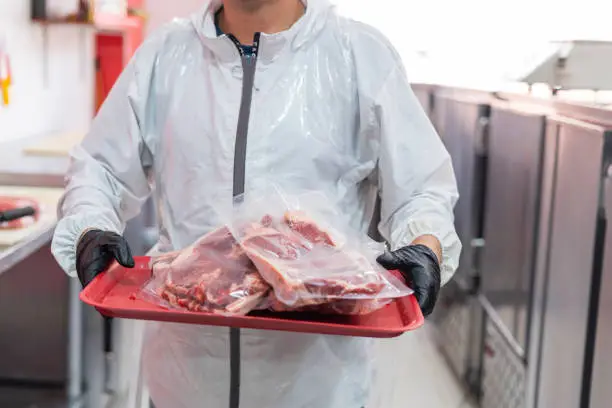Prosciutto is a beloved delicacy that graces charcuterie boards, sandwiches, and salads alike. Its rich flavor and delicate texture can elevate any meal. But with such deliciousness comes a question on the minds of many food lovers: how long can prosciutto sit out? Understanding the safe handling of this cured meat is essential for enjoying it without worry. Whether you’re serving it at a gathering or simply enjoying a slice on its own, knowing how to properly store and handle prosciutto ensures you savor every bite safely. Let’s dive into everything you need to know about this exquisite treat!
Understanding Prosciutto: What It Is and How It’s Made
Prosciutto is a dry-cured ham that hails from Italy, renowned for its rich flavor and melt-in-your-mouth texture. This delicacy is made from the hind leg of pigs, specifically breeds like the Italian Large White or Duroc.
The process begins with selecting high-quality meat. After trimming, the pork legs are salted to enhance flavor and preserve freshness. The salt draws out moisture, allowing beneficial bacteria to flourish while preventing spoilage.
Once salted, prosciutto undergoes a lengthy aging process that can last anywhere from several months to over two years. During this time, it develops its distinct taste and aroma through careful monitoring of temperature and humidity.
Traditionally enjoyed thinly sliced, prosciutto can be served in various ways—from wrapping around fresh melon to featuring on gourmet sandwiches. Each bite tells a story of craftsmanship steeped in history and tradition.
The Importance of Proper Handling
Proper handling of prosciutto is crucial to maintain its flavor and safety. This delicate cured meat can spoil easily if not treated with care.
First, always wash your hands before touching prosciutto. Cleanliness prevents the transfer of harmful bacteria that could compromise its quality.
Using a clean cutting board and utensils is equally important. Cross-contamination from raw foods can lead to foodborne illnesses.
Temperature plays a vital role as well. Prosciutto should be stored in the refrigerator when not being served, keeping it fresh for longer periods.
When serving, avoid leaving it out for extended periods. The warmer environment encourages bacterial growth, making proper timing essential.
By following these simple practices, you enhance both the taste and safe enjoyment of this exquisite delicacy.
How Long Can Prosciutto Sit Out?
When it comes to enjoying prosciutto, knowing how long it can sit out is essential. This Italian delicacy has a unique flavor profile that many adore, but its safety depends on handling.
Typically, prosciutto should not be left at room temperature for more than two hours. If the air is particularly warm or humid, reduce this time to just one hour. Bacteria thrive in these conditions, which poses health risks.
Always keep an eye on your serving platter during gatherings. The moment it hits those two hours—be mindful! Wrap any leftovers tightly and store them in the refrigerator promptly.
Understanding these guidelines helps ensure you enjoy every bite of your delicious prosciutto without worry about foodborne illness. Staying informed makes all the difference!
Risks of Eating Spoiled Prosciutto
Eating spoiled prosciutto can lead to serious health issues. When this cured meat goes bad, harmful bacteria may proliferate. Consuming these pathogens can result in foodborne illnesses.
Symptoms might include nausea, vomiting, or diarrhea. In severe cases, it could even require medical attention. The risk increases if the prosciutto has been left out too long.
Moreover, spoilage isn’t always easy to detect just by smell or appearance. Even a slight change in texture or color can indicate degradation that’s invisible to the naked eye.
People often underestimate how quickly prosciutto can spoil under improper conditions. It’s crucial to be vigilant about storage and handling practices for safety’s sake. A little caution goes a long way when enjoying this delicacy without consequences.
Tips for Safe Storage and Preservation
To keep prosciutto fresh, proper storage is essential. Wrap it tightly in parchment paper or wax paper before placing it in a plastic bag. This method allows the meat to breathe while preventing moisture build-up.
If you have a vacuum sealer, use that for optimal preservation. Vacuum-sealed prosciutto can last much longer and maintain its flavor profile better than other methods.
For short-term storage, refrigerate your wrapped prosciutto at temperatures below 40°F (4°C). If you’re planning to enjoy it later, freezing is an option but may alter the texture slightly.
When serving prosciutto at gatherings, only take out what you need. Keeping the rest refrigerated until needed will help avoid waste and maintain freshness throughout your event.
Always check for any off smells or discoloration before consumption—better safe than sorry!
Creative Ways to Use Leftover Prosciutto
Leftover prosciutto doesn’t have to go to waste. It can elevate a variety of dishes with its savory flavor.
Consider wrapping it around asparagus or green beans before roasting them. The salty, crispy goodness enhances the vegetables beautifully.
You can also toss pieces into pasta dishes. They add a delightful smokiness that pairs well with creamy sauces and fresh herbs.
Try making a simple breakfast by adding prosciutto to scrambled eggs or an omelet. The richness complements the eggs perfectly.
For something refreshing, create a salad topped with arugula, figs, and slices of prosciutto. This combination offers both sweetness and saltiness in every bite.
Blend leftover bits into homemade pizza for an easy upgrade. Just sprinkle it on top right before baking for that perfect finish!
Conclusion: Enjoying Prosciutto Safely and Deliciously
When it comes to enjoying prosciutto, safety and flavor go hand in hand. Understanding how long prosciutto can sit out is key to savoring its rich taste while avoiding health risks. Proper handling and storage are essential, ensuring that you get the most from this delicacy.
By adhering to recommended time frames for leaving prosciutto at room temperature, you can minimize any potential hazards. Remember that fresh or sliced varieties may have different guidelines than whole pieces. Always trust your senses—if something seems off, it’s better not to take a risk.
Use creative methods to incorporate leftover prosciutto into various dishes. Whether topping a salad or wrapping around vegetables, there are countless ways to enjoy it without waste.
Enjoy every bite of your prosciutto experience by following these simple yet effective tips for safe handling and preservation!



